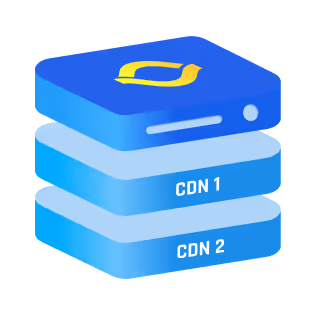Content has always been important for online platforms and websites. Yet, we often overlook another crucial aspect that quietly forms the backbone of a website: the static content.
Without these stable, unchanging elements, the internet as we know it, would be totally different. From the images on your favorite blog post to the style sheets that give it an aesthetic appeal, static content silently shapes your online experience.
What is Static Content?
In the simplest terms, static content refers to files that are delivered to a user’s browser exactly as they are stored on your server. This content doesn’t alter or adapt based on user inputs or behaviors.
Static content usually includes elements like HTML files, Cascading Style Sheets (CSS), JavaScript files, images, PDFs, and more. You can think of static content as the same image served to all users in the same manner.
In contrast to dynamic content, which undergoes server-side processing before reaching the user, static content is sent to the user’s browser directly from the server without any alteration. You can think of dynamic content as a clock. Depending on the time zones, and the current time, each user will get a different output, thus making it user-centric.
Though, in the grand scheme, static content lays the foundation of your website’s design and structure, providing users with consistent experience each time they visit your site.
{{cool-component}}
How Is Static Content Generated?
Static assets can be authored in a plain text editor, but most modern teams rely on a build pipeline that transforms human-readable source files into fast, minified artifacts ready for deployment.
- Authoring Layer
- Hand-coded HTML/CSS/JS – still common for microsites and email templates.
- Static-Site Generators (SSGs) – tools such as Hugo, Jekyll, Eleventy, Astro, Gatsby, and Next.js “static export.” They convert Markdown, MDX, or template files into pre-rendered HTML at build time.
- Headless CMS + Build Hook – editors update content in a CMS (e.g., Contentful, Strapi, Sanity). A webhook triggers the build system to pull new data and regenerate affected pages.
- Build & Transform
- Transpilation – Babel, TypeScript, or PostCSS convert next-gen syntax to widely supported JavaScript/CSS.
- Bundling – Vite, esbuild, Rollup, or Webpack package modules and tree-shake unused code.
- Minification & Compression – terser, cssnano, or imagemin strip whitespace, comments, and metadata; optional pre-compression yields .gz and .br variants.
- Asset Fingerprinting – content hashes (e.g., main.37f9c3.css) ensure browsers fetch a new file only when content actually changes, solving cache-invalidation headaches.
- Output & Deploy
The pipeline emits a dist/ or public/ folder containing flat HTML, optimized images, fonts, and script/style bundles. These artifacts are then pushed to an object store (S3, Azure Blob), a static-hosting platform (Netlify, Vercel, GitHub Pages), or a traditional web server.
Pre-rendering at build time eliminates server-side computation on each request, unlocking speed, scalability, and simpler security postures.
The Benefits of Static Content
Utilizing static content in your website isn’t all lows or highs, but it does come with very interesting benefits:
- Static content can be stored as a cache on a Content Delivery Network (CDN) and even in browser's cache, allowing it to be delivered quickly to the end-user. Therefore, even if the cache isn’t locally stored, it will still improve performance.
- Since static content doesn’t require server-side processing, it’s typically faster to load compared to dynamic content. This efficiency not only enhances user experience but also positively impacts SEO ranking, as search engines favor websites that load quickly.
- Given its inherent simplicity, scaling static content is straightforward. The content can be distributed across multiple servers by CDN(s) (Content Delivery Networks), effectively managing large traffic spikes, and maintaining consistent website performance.
- With no database to exploit or server-side processing to manipulate, static content offers a higher level of isolation between the end-user’s demand and the origin’s infrastructure. Though, this does not mean it's entirely immune to attacks, but the potential vulnerabilities are significantly less compared to dynamic content.
- Owing to its simplicity, static content is easier to deploy and host. Several platforms offer static content hosting services, such as Amazon S3, GitHub Pages, and Netlify, enabling an effortless deployment process!
The Difference Between Static Content to Dynamic Content
The distinction between static and dynamic content lies in how and when the content is generated and delivered. We’ve already discussed how static content is just a culmination of HTML, CSS, and JavaScript files, waiting to be sent to the user’s browser upon request.
On the other hand, dynamic content is generated on-the-fly based on various parameters such as user behavior, preferences, time, location, and so on.
A common example of dynamic content is an online game environment. The inventory updates, the movement of other players, the in-game notifications - all are great examples of dynamic content. It’s similar to how API traffic, or finance transactions work – everything is unique for each user.
Static content is like the set design and characters in a video game, unchanging and pre-defined. Dynamic content, on the other hand, is like the score and player decisions, ever-changing based on the player’s actions.
For example, browsing a website from mobile phones, we will always be served a static image from the CDN cache, which is then optimized for our mobile resolutions.
For a more robust understanding of these differences, be sure to check out our analysis on dynamic content vs static content.
Measuring Static Performance (Core Web Vitals & Asset Budgets)
Shipping static files is only half the battle; you need evidence that they load quickly and stay slim over time.
Best Practices for Optimizing Static Content
While static content possesses inherent advantages in terms of speed and security, optimizing it will still unlock a new realm of performance and user experience for your website.
Let’s see how you can get the best out of static content with the practices listed below:
1. Use Content Delivery Networks (CDNs)
CDNs are networks of servers spread across different geographical locations, which store copies of your static content.
When the user in question requests the content, it’s served from the server closest to them, reducing the latency and improving load times.
CDNs are optimized to implement a cache static content delivery strategy, thus augmenting website performance in your favor. CDN static content is often considered an integral part of an effective CDN strategy.
2. Enable Browser Caching
This allows static files to be stored in the user’s browser after their initial visit.
Now, whenever the website is revisited by the same users, the content is served from their local cache rather than the server having to re-fetch it, leading to marginally faster loading times!
3. Minify and Combine Files
Employing these practices can directly reduce the amount and size of data that needs to be transferred, improving load speeds.
- Minification involves removing unnecessary characters (primarily spaces and comments) from the code without altering its functionality.
- Combining files means merging multiple similar files (like several CSS or JavaScript files) into a single gigantic file.
4. Optimize Images
A significant part of your static content is often attributed to Images.
Use appropriate file formats (like WebP, AVIF, or JPEG XR), compress images without losing quality, and implement lazy loading where images only need to be loaded when actually needed.
This directly impacts your load speed scores, and allows for a better and smoother user experience!
5. Regularly Audit and Update Content
One of the most important yet overlooked parts of this process is keeping content “fresh”. Audit your static content regularly, remove outdated information and deal links, and keep it fresh and relevant. Here’s how you can achieve that:
- Defining a Relatively Short Time-To-Live (TTL)
One way to manage the freshness of your content is through effective utilization of Time-To-Live or TTL. It serves as a timer for each piece of data in a CDN’s cache.
Once the specified TTL duration expires, the CDN will no longer serve that cached content to users, which forces it to fetch an updated version from the original server.
- Leveraging Purge Capability
Another method to keep the content up-to-the -minute is by leveraging the purge capabilities of a CDN. This feature allows you to manually remove content from a CDN’s cache, making it an effective tool for ensuring that outdated or irrelevant content is not being served to users.
Once purged, on the next user request, the CDN will retrieve the most recent version of the content from the original server.
Conclusion
In essence, while static content is typically less complex than its dynamic counterpart, it forms the backbone of your website and plays a critical role in delivering a consistent, efficient user experience.
Proper understanding, strategic implementation, and diligent optimization of static content can significantly augment your website’s performance, enhancing user engagement, and ultimately, achieving your digital goals.
FAQs
1. How does static content differ from dynamic content regarding delivery and user experience?
Static content is pre-built and served to every visitor exactly the same way, so servers simply read a file and respond; no database or code execution required. Dynamic content is assembled on-the-fly, tailoring each page per user or context. This fundamental dynamic content vs static content split affects scalability, speed, and personalization depth.
2. What are common examples of static content on websites?
Typical static web content includes HTML files, CSS style sheets, JavaScript bundles, logo images, icons, PDFs, font files, and pre-rendered videos or screenshots. These assets rarely change between users and sessions, making them ideal for long-term caching and aggressive performance optimizations.
3. Why is static content easier to cache and distribute via CDNs compared to dynamic content?
Because static content never changes per request, edge nodes can store identical copies indefinitely without risking stale personalization or security leaks. Dynamic pages, however, may depend on sessions, cookies, or real-time data, so they require cache busting, short TTLs, or bypass rules that limit CDN efficiency.
4. What are the main benefits of using static content for websites?
Static assets simplify hosting, cut infrastructure costs, and reduce attack surfaces; no runtime means fewer moving parts to exploit. They scale effortlessly via object storage and CDNs, deliver near-instant responses worldwide, and free developer time for features instead of server maintenance, making static content a high-ROI choice.
5. How does static content contribute to faster page load times and improved SEO rankings?
Lightweight, cache-friendly files minimize Time to First Byte and Largest Contentful Paint, core metrics in Google’s ranking algorithm. Faster pages lower bounce rates and boost engagement, signaling quality to search engines. Therefore, strategically optimized static content directly supports better user satisfaction and stronger SEO visibility.



.png)
.png)
.png)






